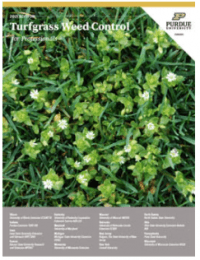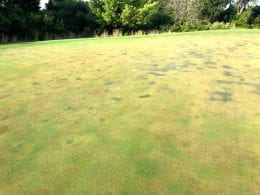By Dr. Jack Fry
This blog post was presented last year, but we’re approaching that time of year again when crabgrass and other annual grassy weeds are approaching emergence.

As a reminder, if you want more detailed information on weed control in general, consider getting this publication that was developed by several state universities, including K-State, and was led by Purdue: “Weed Control for Turfgrass Professionals”
Preemergence herbicide applications for crabgrass, goosegrass, foxtail, and other annual grasses are underway. Here are some bullet points to consider to increase the efficacy of the herbicide you use.
Maintain turf density and mow higher. Good turf density resulting from proper cultural practices for the grass you’re managing reduces encroachment of all weeds, including annual grasses. Mowing at the higher end of the recommended range has consistently shown significantly lower populations of crabgrass and other annual grasses than mowing at lower mowing heights.
Apply before emergence. Not all annual grass species emerge at the same time. For example, goosegrass emerges later than crabgrass. However, even within a species, emergence of new seedlings occurs throughout spring and summer. With most preemergence herbicides, when seedlings have emerged, they will not effectively control those plants. However, the application will control emergence of grasses beyond that date. Dithiopyr (Dimension) does provide control of crabgrass that has emerged but has not begun to produce tillers.
Use effective strategies to guide application. Calendar dates, soil temperature, flowering of ornamentals, and other strategies are all used to help guide applications and maximize herbicide residual during the period annual grasses emerge. Here are a couple of articles related to this subject:
https://blogs.k-state.edu/turf/methods-of-predicting-crabgrass-emergence/
https://blogs.k-state.edu/turf/flowering-ornamentals-and-crabgrass-emergence/
Apply uniformly. Uniform application is critical – just like distributing paint evenly over your house is aesthetically pleasing. If you leave a section of the house unpainted, it’s clearly visible. Good annual grass control requires uniform application; if an area is not treated, it’s likely you’ll seed weed emergence there. Uniform application is achieved by proper spreader or sprayer calibration, colorants that indicate areas that have been treated with liquid products, and applying the product in two directions (half rate in each).
Split applications. Preemergence herbicides generally provide better suppression of annual grasses when applications are split (1/2 rate each application), usually 6 to 8 weeks apart. This allows a higher level of herbicide presence on the soil surface, which will minimize weed emergence. Here’s an article from Purdue on this subject:
https://turf.purdue.edu/wp-content/uploads/2012/06/15_AGRY_Patton_sequential20apps.pdf
Water in after application. For preemergence herbicides to be activated and ensure uniform distribution on the soil surface, irrigation (or rainfall) after application is needed.
Find more information on weed control by clicking on the tags on the blog (left column), such as “weed control,” “crabgrass,” etc., or search by category on the right side of the page.
***Mention of trade names or commercial products in this article is solely for identification purposes and does not imply recommendation or endorsement, nor is criticism implied of similar products not mentioned by Kansas State University.***
Don’t forget to follow the K-State Turf and Landscape Team on Twitter @KSUTurf
Also, visit our facebook page www.facebook.com/KSUTurf

 Perennial ryegrass has been widely used in the transition zone over the years. It used to be quite popular, but disease issues and water costs have reduced its use in Kansas. That said, it’s what makes Augusta National Golf Club beautiful for the Masters. Learn more about perennial ryegrass
Perennial ryegrass has been widely used in the transition zone over the years. It used to be quite popular, but disease issues and water costs have reduced its use in Kansas. That said, it’s what makes Augusta National Golf Club beautiful for the Masters. Learn more about perennial ryegrass 
 Wes Dyer, Ph.D. and Manoj Chhetri, Ph.D. both finished their doctoral degrees at K-State in 2021; each had focus on water savings as part of their research. Wes is employed with Irrometer Company, Inc. in Riverside, CA and Manoj is a horticulture extension agent for the University of Missouri. Dr. Cathie Lavis joins them to present strategies for saving irrigation water on this video recorded at the 2021 Kansas Turfgrass Field Day. Hear about the effectiveness of soil moisture sensors in contributing to water savings, and how irrigation heads differ in water delivery. To view, click
Wes Dyer, Ph.D. and Manoj Chhetri, Ph.D. both finished their doctoral degrees at K-State in 2021; each had focus on water savings as part of their research. Wes is employed with Irrometer Company, Inc. in Riverside, CA and Manoj is a horticulture extension agent for the University of Missouri. Dr. Cathie Lavis joins them to present strategies for saving irrigation water on this video recorded at the 2021 Kansas Turfgrass Field Day. Hear about the effectiveness of soil moisture sensors in contributing to water savings, and how irrigation heads differ in water delivery. To view, click 



 Doug Melchior is a K-State graduate and KU fan (he spent a couple of years there before transferring to K-State) who has served as Manager of Golf and Grounds in Overland Park since 2015. He worked for the City of Overland Park for years prior to advancing to this position. Doug oversees the operations of the Overland Park public golf courses 27 holes + a 9-hole par 3 course at Sykes Lady Golf Course and 18-holes at St. Andrews. The number of rounds they host is among the highest in the Midwest, which influences labor and maintenance.
Doug Melchior is a K-State graduate and KU fan (he spent a couple of years there before transferring to K-State) who has served as Manager of Golf and Grounds in Overland Park since 2015. He worked for the City of Overland Park for years prior to advancing to this position. Doug oversees the operations of the Overland Park public golf courses 27 holes + a 9-hole par 3 course at Sykes Lady Golf Course and 18-holes at St. Andrews. The number of rounds they host is among the highest in the Midwest, which influences labor and maintenance.  Jack Fry, long time K-State faculty member, has been honored with Golf Course Superintendents Association of America’s (GCSAA) Outstanding Contribution Award. From GCSAA’s post: “A fixture in turfgrass education, the scientist and researcher has influenced the expertise and career paths of many in the golf industry.”
Jack Fry, long time K-State faculty member, has been honored with Golf Course Superintendents Association of America’s (GCSAA) Outstanding Contribution Award. From GCSAA’s post: “A fixture in turfgrass education, the scientist and researcher has influenced the expertise and career paths of many in the golf industry.” 